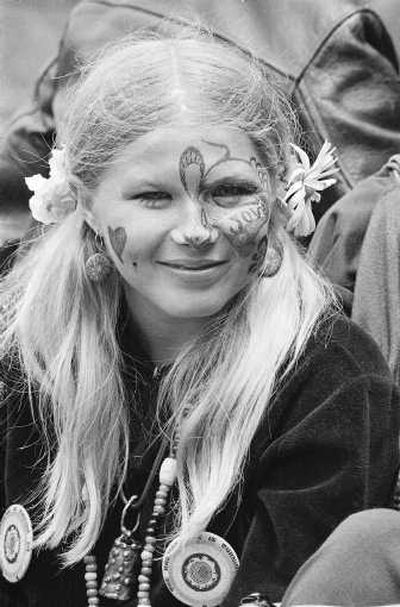Look who’s 40

SAN FRANCISCO – The “Summer of Love” turns 40 this year, and parties are planned.
So, is this the death knell for Haight-Ashbury’s hipness? If 30 was “over the hill” in the ‘60s, surely 40 represents a headlong tumble toward an open grave.
Actually, by the time of the Haight district’s famed “Summer of Love” in 1967, when the young and the restless flocked here from all over the nation, the Haight’s hippies were already a dying cliché by their own proclamation – they even staged a mock funeral.
Time had done a cover story on them. Life, another magazine of the mainstream, ran a major take on the San Francisco scene.
But the real nail in the coffin of coolness, according to Haight historian Barney Hoskyns, was driven that spring when Gray Line tour buses started rumbling slowly up and down the street with tourists from Iowa, noses pressed to windows, gawking at the tie-dyed and tuned-in.
The tour was called the “Hippie Hop.” Ouch.
No reports on whether the Hippie Hop will make a comeback this summer, but the 40th birthday isn’t going uncelebrated.
A Labor Day weekend bash is planned for Golden Gate Park, right next door, and a July concert reunion brings nostalgic names such as Big Brother & the Holding Company, Moby Grape and Jefferson Starship to Monterey, two hours to the south.
Meanwhile, we found it’s easy to stage your own observance – on a walking tour of Haight-Ashbury with an authentic hippie guide who’s been around long enough to know the neighbors.
“Mommy and Daddy brought me out here from New York to hippie-fy me during the ‘Summer of Love’ because they thought I was too conservative, and boy did they regret it,” said Izu, our 53-year-old guide.
She was 14 in 1967, and moved to the Haight permanently in 1971. (Her last name is Interlandi, but since when do hippies use last names? She doesn’t.)
In her tie-dyed skirt and long black hair, Izu gabbed and laughed nonstop as we wandered the district on the 2 1/2 -hour Haight-Ashbury Flower Power Walking Tour, which is offered three times weekly.
We saw the Victorian house where the Grateful Dead used to live, right across the street from the Victorian where the Hell’s Angels motorcycle club used to hang out.
Standing on Ashbury Street between the houses, Izu told us some insider stories.
“A lady from Long Island bought the Hell’s Angels house in 1996, and she made it beautiful – it was a dump when the Angels had it,” she said.
“And every Thanksgiving, hundreds of Hell’s Angels still ride by to honor this house and she comes out to greet them in full black leather. Then they go down to eat together at the People’s Cafe on Haight Street.”
When Jerry Garcia, the Grateful Dead band leader, died in 1995, hundreds of “Deadhead” fans showed up at the house at 710 Ashbury. A couple who have owned the house since 1980 were respectful of Garcia’s memory, Izu said.
“People came and made an altar up the steps of the house, with candles, crystals and flowers,” she said, “and the owners carefully walked around everything when they came and went.”
What got to me was the mural on the side of the Hamilton Methodist Church on Belvedere Street. It’s one of those artworks that is a real statement of age and place – like Grant Wood’s “American Gothic,” say, or maybe an Andy Warhol painting.
Along with the faces of Martin Luther King Jr., John F. Kennedy and (we’re not sure why) Harry Truman, were (even more curiously) the unmistakable, earnest likenesses of Linc, Pete and Julie, the three stars of “The Mod Squad” TV show (1968-73).
Next to them, in this happy, hippie world painted by muralist Charles Lobdell in the 1970s, a circle of winsome and peaceful people danced hand in hand around a spreading oak tree.
But wait. Why’s the Mod Squad there? Weren’t those guys, uh, narcs?
Yes, admittedly, they were narcs with a heart and they knew how to wear their bell-bottoms but why are they memorialized in a mural in the middle of hippie-dippy Haight-Ashbury? Maybe it’s a statement of how much pop there is in the culture here.
In 1967, Hunter Thompson wrote of the neighborhood, “There will always be at least one man with long hair and sunglasses playing a wooden pipe, a hairy blond fellow wearing a Black Bart cowboy hat playing bongos … and a dazed-looking girl wearing a blouse but no bra.”
On our walk, I think we passed each of them along with a modern contingent of panhandlers of all ages.
We also saw where Country Joe McDonald shared a place with Janis Joplin; met an old hippie named Waterfall who changed his name and quit his job after Woodstock changed his life; and saw a photo exhibit in a private Psychedelic Museum devoted largely, it seemed, to the local rock stars who died by age 27 from drugs or alcohol.
And at the end of the tour, we all got big, sincerely sweet hugs from our guide, who bid us farewell like lifelong friends.
All you need is love? For some, at least, that’s still what rocks the Haight.